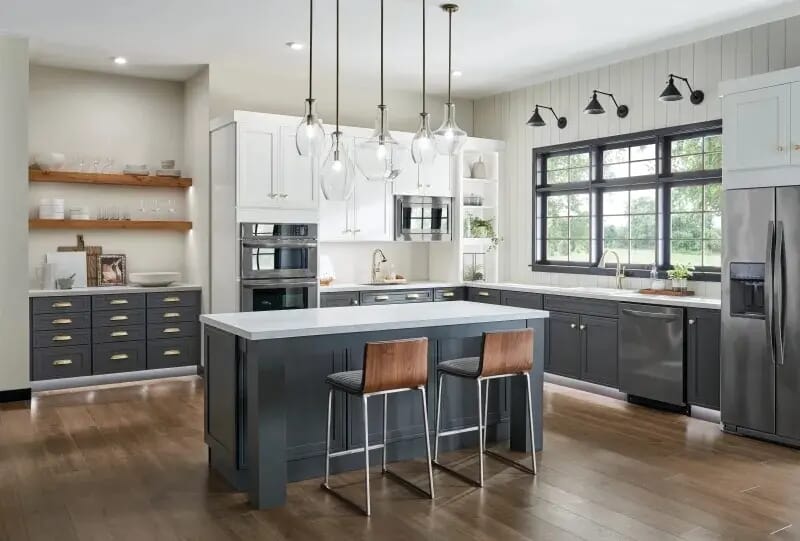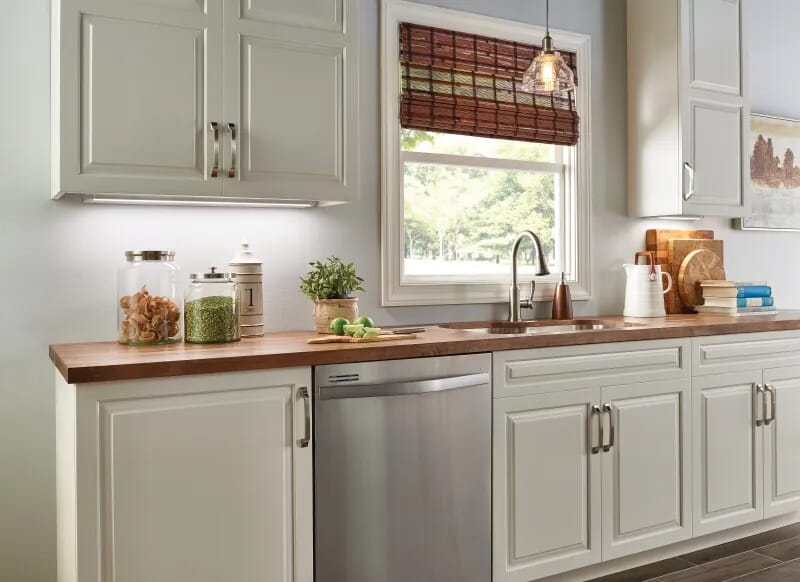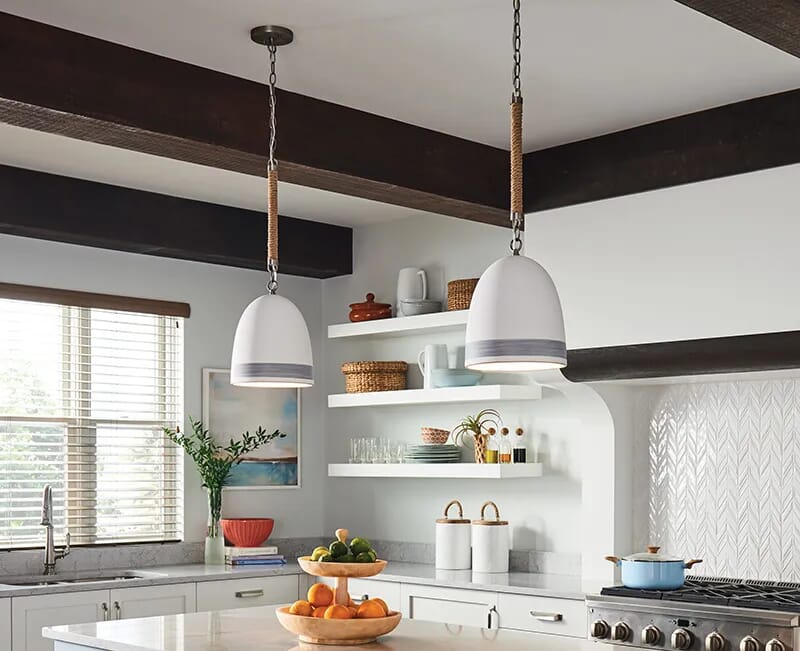Kitchen Lighting Buying Guide

In many homes, the kitchen becomes the heart of it all—not only for cooking and eating, but also for socializing, reading, doing homework, browsing the internet, making crafts and so on. Because of this, kitchens require more task-specific lighting than what is often found in the rest of the home. That's why we wrote this Kitchen Lighting Buying Guide!
Because kitchens are one of the most valuable spaces in a home and people buy kitchen lights with the intent of keeping them for about a decade, it's important to make sure you get the right kitchen light! Start with questions like these:
Do you need a light fixture to illuminate the whole room? Do you need more light for cooking and food prep? Do you want to pep up your island (if you have one) or add pops of color to a neutral space? Does your kitchen just have less-than-ideal lighting that makes it feel more like a cave?
Now read on for help with answering these questions.
Kitchen Lighting Styles
Here are the three most commonly used kitchen lighting styles:
Traditional style lights often have elegant designs adorned with decorative flourishes and touches.
Transitional style lights have a less adorned look than traditional styles. It is very versatile.
Contemporary style lights feature a very minimal, streamlined look.
There are other lighting styles, like coastal, farmhouse and industrial, available too!
Kitchen Lighting Types and Uses
Overhead and ceiling-mounted light fixtures are used for general purpose ambient lighting. Under-cabinet lights are great for focused task lighting for things like prepping food. Accent light takes many forms, including LED tape lighting that can be used in nearly endless kitchen applications. Here's a closer look at each kind of kitchen lighting.
Ambient or general kitchen lighting is generally mounted to the ceiling and used to wash the room in light. This is necessary for every kitchen and helps transform spaces from dark caves to warm hearts. Fixtures you can use to provide ambient kitchen lighting include chandeliers, pendants, lanterns, linear chandeliers and recessed can lighting.
If you have a small kitchen or one with a low ceiling, an ambient lighting fixture that hangs close to the ceiling is an ideal choice. A flush ceiling light sits flush with the ceiling while a semi flush ceiling light hangs down slightly. But if you have more space to work with or a wider area to illuminate, larger fixtures like chandeliers and big pendants could be just right.
All of these ambient light fixtures come in a wide range of shapes, sizes, styles and finishes to create the best match for your kitchen.
Looking to create a warm and cozy feel with your ambient lighting? Try using bulbs with a warm white color temperature on the Lighting Facts label or, in the case of fixtures where the LED lights are integrated, look for the color temperature in the fixture's specifications. You can also add a dimmer to really finely control the color temperature of the light at any given time. Note that LED lights and incandescent dimmers do not work well together, so if you wish to dim LED bulbs, you should use an LED-compatible dimmer.

Under-cabinet lighting includes different styles: all-in-one linear, modular linear (with power connected from one fixture to another in a process called daisy chaining), surface mount puck, recessed mount puck and LED tape. Surface mount fixtures are the easiest to place if you're adding under-cabinet lighting to an already finished kitchen. Modular linear fixtures feature ease of installation and expandability.
While under-cabinet lighting is most often used to provide focused and helpful task lighting under a cabinet, helping people do things like cut and prep food, it also can be placed above a cabinet to provide an interesting glow directed at the ceiling. You can also use under-cabinet lighting, especially the puck styles, to light glass-front cabinets that display artful yet rarely used items.
For another under-cabinet-like option, use LED tape lighting at the toe kick to create subtle yet helpful light that is especially good for when you go into the kitchen seeking late night snacks and need just a little light. LED tape is so versatile that it can be used for many different kitchen lighting tasks. It can bend at 45-degree angles, it's waterproof, it can adhere to practically any surface and it's easy to install. There's even a variety of LED tape that can change colors on command. The only limit is your imagination.
For a kitchen island, there are a few different types of fixture you can use. While pendants are the most popular choice, mini chandeliers (sometimes called chandelettes) are sometimes used to sparkling, elegant effect in that area too. Linear island fixtures can also be used above an island or table. Some island fixtures even have independently adjustable light sources, much like track lighting!
Sconces can provide helpful and stylish accent and decorative lighting in many kitchen areas. They are commonly mounted in a matching pair beside a sink, in a pass-through or above an area that needs more focused task lighting, such as a food prep area. Sconces with adjustable necks (wall lamps) are a great idea in the kitchen since they can be moved right to where they need to be at any given moment. You can also consider sconces for accent lighting, directing illumination at objects and details you want to spotlight in your kitchen, or pick sconces mainly for their decorative looks.
Sizing Kitchen Lights
For kitchen ambient lighting by way of a single fixture, measure the length and width of the room you wish to light. Then convert this number to inches by adding them together. That number is the ideal width of the fixture. For example, an 18" wide fixture would be ideal for an 8'x10' room. The standard height for hanging a chandelier in ambient use is 7 feet, but adjust this as needed for your home depending on the size of the fixture, your ceiling heights, heights of the room's occupants and so on.
For recessed can lighting, the cans should be placed directly over the corners of the countertops and spaced about 3 feet apart. 6 inch-size cans are recommended for the best beam spread. The smaller the can, the closer together they need to be, which means more holes in your ceiling and more fixtures. If your kitchen ceiling is white, use white recessed can trim so it looks like the cans disappear into the ceiling.
If you are using a chandelier or single large pendant above a kitchen island or table, measure the width or diameter of your table. Then look for lights that are between 2/3 and 3/4 of that width or diameter. Keep in mind that a fixture with a busy or complex design will actually appear larger, so if that's what is catching your eye, you'll want to scale your maximum width down slightly. Assuming you have 8-foot ceilings, the bottom of the fixture should hang between 30 and 36 inches above the tabletop. But if your ceilings are higher, the suggestion is to add 3 more inches above the table for each additional foot of ceiling.

For hanging pendants above a kitchen island or table, start with 28-34 inches above said table as a rough guideline, but make sure to consider the sight lines of the people in the room so no one gets glare in their eyes or runs the risk of hitting their head on the pendant. Mount a pendant every 2 feet or so above a kitchen island. While many people choose identical pendants and mount them at the exact same hanging height, some eclectic kitchens make wonderful use of differing pendants or pendants hung at different heights.
If you want to add sconces to your kitchen, keep in mind that the closer you will be to whatever the sconce is lighting, the smaller the sconce should be. If the sconces have shades, put the bottom edges of the shades a little below eye level (60 to 68" from the floor). Consider eye level when it comes to reducing glare and ensuring that the tallest person in the space can't see down into the sconce. ADA-compliant sconces are allowed to extend no more than 4 inches from the surface, which is good for narrow or small spaces.
For under-cabinet lighting, consider the size of the fixture and also the placement. Mounting under-cabinet lights in the back of the cabinet may cause glare if you sit in the light's line of sight. Mounting in front may create a glare issue if you have reflective countertops and backsplashes. Keep your kitchen's specifics in mind.
If you're thinking of placing lighting over your stove, there are some very important things to keep in mind. Since stoves generate lots of heat and can also splatter grease or oil, hanging a pendant is not the most ideal solution. (If you still want to, though, you must hang it a minimum of 30" above the stove and ideally 30" to 40".) Consider the heights of the people in your home and make sure the tallest person won't hit their head on the pendant when standing at the stove. Other lighting solutions for above the stove that might be a better fit than pendants include vent hoods with integrated lights, under-cabinet lights mounted in cabinets above the stove, adjustable recessed light fixtures on the ceiling or track lighting.
This kitchen lighting guide covered a lot of ground! Armed with all of this knowledge, you will certainly get the right kind of kitchen lighting for your needs!
If you need more help or advice on kitchen lighting, call our trained lighting specialists at 1-866-688-3562 or reach out on social media.
Emma Harger-Young – Lights Online
